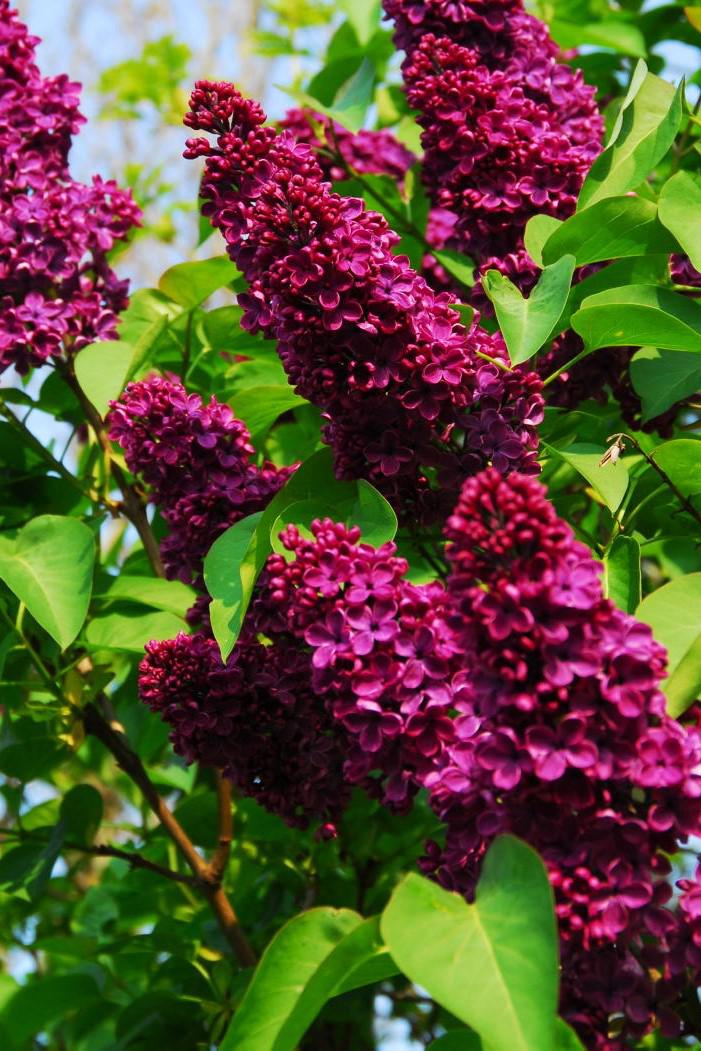Name: Lilac.
Botanical name: Syringa vulgaris. The first part of the botanical name refers to a tube, as the individual flowers have a tube over most of their length. Vulgaris is not a word of deprecation; there is nothing vulgar about it – in fact it’s the opposite, in this sense it is ‘well remains’, or of the crowd.
Family name: Olive family or Oleaceae. The olive itself survives in mild gardens on the coast and the other members are commonly grown in gardens, privet and forsythia, while the common ash, a native tree, grows wild on hedgerows.
Like most spring flowering trees and shrubs, this is a very good flowering year for lilac, which always responds to a warm summer, carrying masses of flower buds over to the following year. It is native to warm parts of south-east Europe and grows really beautifully in France and other warm countries, but not in hot, dry localities. It does well here when the summer is not too cold or wet, flowering well the following year. After a dull summer, it tends to be leafy and not flower much.
Garden value
The ordinary common lilac, Syringa vulgaris, is the most popular. It has pale lilac flowers, tiny tubular individual flowers massed in pointed clusters at the tips of shoots. There is natural variation of colour, with some seedlings lighter in colour, some dark. Over the centuries, especially in France, many named varieties have been selected for darker or lighter colour and double flowering, which makes the flowers look fuller and larger.
‘Katherine Havemeyer’ has double flowers, pale purple-lilac, very well scented; ‘Belle de Nancy’ is purple pink; ‘Vestale’ is white and of graceful shape; ‘Volcan’ is dark red-purple; ‘Firmament’ has pink buds that open lilac-blue; ‘Marechal Foch’ is a lovely dark red-purple kind. ‘Souvenir de Louis Spaeth’ is reddish purple and a reliable kind. ‘Charles Joly’ is double, reddish purple and late-flowering. ‘Maud Notcutt’ is white with single flowers, while ‘Mme Lemoine’ is white and double flowered. But there are dozens, scores of varieties. These named varieties are generally grafted onto the common Syringa vulgaris. This is forever throwing up suckers and if these are neglected and allowed to grow, they often take over from the grafted top.
Garden use
As the years go by, this might not even be noticed, especially if the original planter and purchaser of the named sort has passed on. And lilac is that kind of plant, it is very long-lasting — like any suckering tree, it can revive itself from many a setback and carry on. The lilac tree that might be present in childhood can still be thriving many decades later and not look much different than it once did. This is a feature of lilac that makes it such a valued part of a country garden, as it has an old-fashioned air to it. Plant at any time from a pot.
Trim back spring rockery plants

Aubrieta.
As the spring rockery flowers go over, they can be trimmed lightly with a hedge clippers. Although this is by no means essential, many of these plants benefit from this light ‘pruning’. The likes of aubrieta, arabis, alyssum and saxifrages can be treated in this fashion as soon as the flowers go over. There are several benefits.
The removal of the flower heads leaves the carpets – and these are all carpet-formers – much neater and the shape of the plants hold better with less chance of gaps forming. Taking off the flower heads prevents the waste of energy-producing seeds, and very often these plants will produce a few flowers late in the summer if trimmed now — an added bonus.
Trees, shrubs and roses
Roses are beginning to flower — all the early kinds of climbers and ramblers are already in bloom. The bush roses in beds start a little later. Check tree lupins, birch and honeysuckle for aphids. Check young trees and shrubs to ensure they don’t dry out with them.
Lawns
The weather has been up and down, cold and wet. Lawns have not grown very well. The main growth period is coming to an end. It should now be easier to keep lawns mowed, but mowing should be kept up. The lawn looks neater and is easier to mow.
Fruit, vegetables and herbs
Repeat sow lettuce, beetroot, white turnips and peas. Thin out and transplant vegetables that have reached suitable size and control weeds early. Plant out Savoy cabbage and other winter varieties. Vegetables may be in need of watering.
Flowers
It is late to plant up pots and containers and bedding in beds and borders, but still worthwhile. Be sure to control weeds among bedding plants after rain – these will take away from the planting if they are allowed to make growth. Water plants in pots.
Greenhouse and house plants
Make sure to water and feed all greenhouse plants well during the coming weeks to maintain vigorous growth during the longest days. Use a greenhouse shading material now if the house is inclined to get too hot. Ventilate well during damp weather.
Bord Bia is sharing easy-to-follow garden design and planting ideas to help the public create a dream garden at home this year for Bloom 2021. The physical event has once again been cancelled due to the pandemic.
Designed by award-winning Bloom show garden designers, Bord Bia’s seven unique garden plans can be recreated (either fully or in part) at home, according to the time, space and budget one might have. Each of the seven design packs in the series feature a detailed planting plan and planting list which can be downloaded online.
For the full line-up of virtual events taking place and to access these garden designs, visit bordbiabloom.com or follow Bord Bia Bloom on social media @BordBiaBloom.
Read more
In the garden with Gerry Daly: fabulous foxgloves
In the Garden with Gerry Daly: millionaire magnolia
Name: Lilac.
Botanical name: Syringa vulgaris. The first part of the botanical name refers to a tube, as the individual flowers have a tube over most of their length. Vulgaris is not a word of deprecation; there is nothing vulgar about it – in fact it’s the opposite, in this sense it is ‘well remains’, or of the crowd.
Family name: Olive family or Oleaceae. The olive itself survives in mild gardens on the coast and the other members are commonly grown in gardens, privet and forsythia, while the common ash, a native tree, grows wild on hedgerows.
Like most spring flowering trees and shrubs, this is a very good flowering year for lilac, which always responds to a warm summer, carrying masses of flower buds over to the following year. It is native to warm parts of south-east Europe and grows really beautifully in France and other warm countries, but not in hot, dry localities. It does well here when the summer is not too cold or wet, flowering well the following year. After a dull summer, it tends to be leafy and not flower much.
Garden value
The ordinary common lilac, Syringa vulgaris, is the most popular. It has pale lilac flowers, tiny tubular individual flowers massed in pointed clusters at the tips of shoots. There is natural variation of colour, with some seedlings lighter in colour, some dark. Over the centuries, especially in France, many named varieties have been selected for darker or lighter colour and double flowering, which makes the flowers look fuller and larger.
‘Katherine Havemeyer’ has double flowers, pale purple-lilac, very well scented; ‘Belle de Nancy’ is purple pink; ‘Vestale’ is white and of graceful shape; ‘Volcan’ is dark red-purple; ‘Firmament’ has pink buds that open lilac-blue; ‘Marechal Foch’ is a lovely dark red-purple kind. ‘Souvenir de Louis Spaeth’ is reddish purple and a reliable kind. ‘Charles Joly’ is double, reddish purple and late-flowering. ‘Maud Notcutt’ is white with single flowers, while ‘Mme Lemoine’ is white and double flowered. But there are dozens, scores of varieties. These named varieties are generally grafted onto the common Syringa vulgaris. This is forever throwing up suckers and if these are neglected and allowed to grow, they often take over from the grafted top.
Garden use
As the years go by, this might not even be noticed, especially if the original planter and purchaser of the named sort has passed on. And lilac is that kind of plant, it is very long-lasting — like any suckering tree, it can revive itself from many a setback and carry on. The lilac tree that might be present in childhood can still be thriving many decades later and not look much different than it once did. This is a feature of lilac that makes it such a valued part of a country garden, as it has an old-fashioned air to it. Plant at any time from a pot.
Trim back spring rockery plants

Aubrieta.
As the spring rockery flowers go over, they can be trimmed lightly with a hedge clippers. Although this is by no means essential, many of these plants benefit from this light ‘pruning’. The likes of aubrieta, arabis, alyssum and saxifrages can be treated in this fashion as soon as the flowers go over. There are several benefits.
The removal of the flower heads leaves the carpets – and these are all carpet-formers – much neater and the shape of the plants hold better with less chance of gaps forming. Taking off the flower heads prevents the waste of energy-producing seeds, and very often these plants will produce a few flowers late in the summer if trimmed now — an added bonus.
Trees, shrubs and roses
Roses are beginning to flower — all the early kinds of climbers and ramblers are already in bloom. The bush roses in beds start a little later. Check tree lupins, birch and honeysuckle for aphids. Check young trees and shrubs to ensure they don’t dry out with them.
Lawns
The weather has been up and down, cold and wet. Lawns have not grown very well. The main growth period is coming to an end. It should now be easier to keep lawns mowed, but mowing should be kept up. The lawn looks neater and is easier to mow.
Fruit, vegetables and herbs
Repeat sow lettuce, beetroot, white turnips and peas. Thin out and transplant vegetables that have reached suitable size and control weeds early. Plant out Savoy cabbage and other winter varieties. Vegetables may be in need of watering.
Flowers
It is late to plant up pots and containers and bedding in beds and borders, but still worthwhile. Be sure to control weeds among bedding plants after rain – these will take away from the planting if they are allowed to make growth. Water plants in pots.
Greenhouse and house plants
Make sure to water and feed all greenhouse plants well during the coming weeks to maintain vigorous growth during the longest days. Use a greenhouse shading material now if the house is inclined to get too hot. Ventilate well during damp weather.
Bord Bia is sharing easy-to-follow garden design and planting ideas to help the public create a dream garden at home this year for Bloom 2021. The physical event has once again been cancelled due to the pandemic.
Designed by award-winning Bloom show garden designers, Bord Bia’s seven unique garden plans can be recreated (either fully or in part) at home, according to the time, space and budget one might have. Each of the seven design packs in the series feature a detailed planting plan and planting list which can be downloaded online.
For the full line-up of virtual events taking place and to access these garden designs, visit bordbiabloom.com or follow Bord Bia Bloom on social media @BordBiaBloom.
Read more
In the garden with Gerry Daly: fabulous foxgloves
In the Garden with Gerry Daly: millionaire magnolia







 This is a subscriber-only article
This is a subscriber-only article









SHARING OPTIONS: